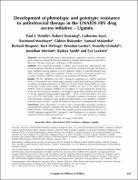| dc.contributor.author | Weidlea, J. Paul | |
| dc.contributor.author | Downingb, Robert | |
| dc.contributor.author | Sozic, Catherine | |
| dc.contributor.author | Mwebaze, Raymond | |
| dc.contributor.author | Rukundo, Gideon | |
| dc.contributor.author | Malamba, Samuel | |
| dc.contributor.author | Respessa, Richard | |
| dc.contributor.author | Hertogsf, Kurt | |
| dc.contributor.author | Larderg, Brendan | |
| dc.contributor.author | Ochola, Dorothy | |
| dc.contributor.author | Mermin, Jonathan | |
| dc.contributor.author | Badara Sambk, Badara | |
| dc.contributor.author | Lackritz, Eve | |
| dc.date.accessioned | 2021-04-21T13:34:14Z | |
| dc.date.available | 2021-04-21T13:34:14Z | |
| dc.date.issued | 2003-07 | |
| dc.identifier.citation | Weidle, P.J., Downing, R., Sozi, C., Mwebaze, R., Rukundo, G., Malamba, S., Respess, R., Hertogs, K., Larder, B., Ochola, D. and Mermin, J., 2003. Development of phenotypic and genotypic resistance to antiretroviral therapy in the UNAIDS HIV Drug Access Initiative–Uganda. Aids, 17, pp.S39-S48. | en_US |
| dc.identifier.issn | 1473-5571 | |
| dc.identifier.issn | 0269-9370 | |
| dc.identifier.uri | http://hdl.handle.net/20.500.12280/2681 | |
| dc.description.abstract | Objective: We describe phenotypic drug resistance, response to therapy, and geno-typic mutations among HIV-infected patients in Uganda taking antiretroviral medica-tions for ≥ 90 days who had a viral load ≥ 1000 copies/ml.
Methods: HIV-1 group and subtype, virologic and immunologic responses to anti-retroviral therapy, phenotypic resistance to antiretroviral drugs, and associated geno-typic mutations among patients at three treatment centers in Uganda between June
1999 and August 2000 were assessed. Therapy was two nucleoside reverse tran-scriptase inhibitors (NRTIs) or highly active antiretroviral therapy (HAART).
Results: All HIV identified was HIV-1, group M, subtypes A, C, and D. Sixty-one (65%) of 94 patients with a phenotypic resistance result had evidence of phenotypic resistance including resistance to a NRTI for 51 of 92 (55%) taking NRTIs, to a non-nucleoside reverse transcriptase inhibitor (NNRTI) for nine of 16 (56%) taking NNRTIs, and to a protease inhibitor (PI) for eight of 37 (22%) taking PIs. At the time of the first specimen with resistance, the median change from baseline viral load was –0.56 log copies/ml [interquartile range (IQR), –1.47 to +0.29] and CD4+ cell count was +35 × 106 cells/l (IQR, –18 to +87). Genotypic resistance mutations, matched with phenotypic resistance assay results and drug history, were generally consistent with those seen for HIV-1, group M, subtype B infections in industrialized countries.
Conclusion: Initial phenotypic resistance and corresponding genotypic mutations among patients treated in Uganda were similar to those with subtype B infections in North America and Europe. These data support policies that promote the use of
HAART regimens against HIV-1, group M, non-B subtypes in a manner consistent with that used for subtype B infections. | en_US |
| dc.language.iso | en | en_US |
| dc.publisher | Wolters Kluwer Health, Inc. | en_US |
| dc.relation.ispartofseries | Aids;17 | |
| dc.subject | Africa | en_US |
| dc.subject | Antiretroviral | en_US |
| dc.subject | HIV | en_US |
| dc.subject | Resistance | en_US |
| dc.subject | Subtypes | en_US |
| dc.subject | Uganda | en_US |
| dc.title | Development of Phenotypic and Genotypic Resistance to Antiretroviral Therapy in the UNAIDS HIV Drug Access Initiative – Uganda | en_US |
| dc.type | Article | en_US |


